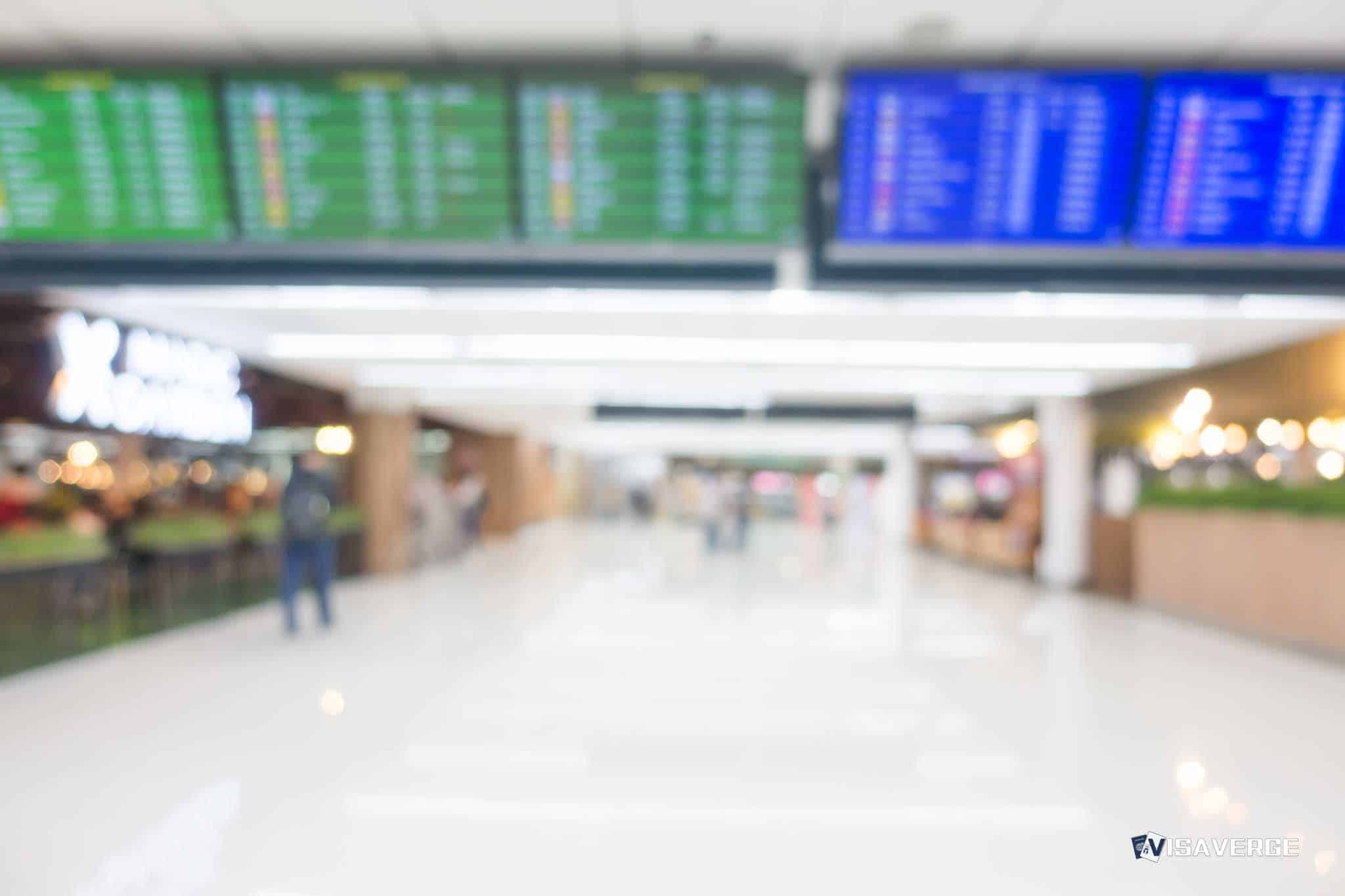Key Takeaways
• February 19, 2025: Drone sighted within 5 km exclusion zone at Edinburgh Airport, causing temporary flight delays.
• Police Scotland seized the drone and reported a 39-year-old man to the Procurator Fiscal for airspace breach.
• UK drone laws ban flights within 5 km of airports without permission; penalties include up to five years in prison.
On the morning of February 19, 2025, flights arriving at Edinburgh Airport faced unexpected delays after a drone was spotted within the airport’s restricted airspace. Police Scotland responded quickly, launching an investigation that led to the seizure of the drone and a 39-year-old man being reported to the Procurator Fiscal, Scotland’s public prosecutor. While the disruption was brief and flights resumed soon after, the incident highlights growing concerns about drone activity near airports and the strict rules in place to protect passenger safety.
This article explains what happened at Edinburgh Airport, the rules around drone use near airports, the role of police and aviation authorities, and what these events mean for travelers, drone operators, and the wider public.

What Happened at Edinburgh Airport?
On February 19, 2025, at about 7:50 am, a drone was seen inside the exclusion zone around Edinburgh Airport. The drone did not enter the airfield or fly over the runway, but its presence was enough to trigger safety protocols. Air traffic control decided to temporarily hold arriving flights as a precaution. Police Scotland was notified right away and began searching for the drone and its operator.
Within a short time, police found and seized the drone. They also identified and reported a 39-year-old man to the Procurator Fiscal for breaking airspace rules. No injuries or direct safety incidents were reported, and the airport returned to normal operations later that morning.
Why Are Drones a Problem Near Airports?
Drones can pose a serious risk to aircraft, especially during takeoff and landing when planes are flying low and close to the airport. Even a small drone can cause significant damage if it hits an airplane, and pilots may not see drones until it is too late to react. Because of these risks, strict rules are in place to keep drones away from airports.
The Rules: Where Can You Fly a Drone?
The Civil Aviation Authority (CAA) sets the rules for drone use in the United Kingdom 🇬🇧. As of July 1, 2025, it is illegal to fly a drone within a 5 km radius of any airport, airfield, or spaceport without special permission. This area is called the “exclusion zone.” The rules apply to both recreational (hobby) and commercial (business) drone pilots.
Key Points About Drone Rules Near Airports:
– No drone flights within 5 km of airports unless you have permission from the airport and the CAA.
– Mandatory registration and competency testing for drones weighing more than 250 grams.
– Ignorance of the law is not a defense—drone operators must know and follow the rules.
– Penalties for breaking the rules can be severe: up to five years in prison and an unlimited fine.
For more details on these rules, visit the Civil Aviation Authority’s official drone guidance.
How Do Police and Authorities Respond to Drone Sightings?
When a drone is spotted near an airport, a series of steps are taken to protect passengers, staff, and aircraft:
- Air traffic control holds or diverts flights to keep planes away from the area where the drone was seen.
- Police and airport security investigate to find the drone and its operator.
- Flights resume only after authorities are sure the area is safe.
In the Edinburgh Airport incident, police acted quickly, found the drone, and took legal action against the person responsible. This fast response helped keep the disruption short and prevented any accidents.
Recent Trends: Are Drone Incidents Increasing?
Yes, drone-related incidents near airports are on the rise across the United Kingdom 🇬🇧. According to the UK Airprox Board, the number of near-misses between drones and aircraft has tripled in the past two years. More than 60% of these close encounters happen within 200 feet of an airport, and over 20% are within just 50 feet.
Most incidents involve commercial jets and single-engine propeller planes, but helicopters are also sometimes affected. Experts warn that many incidents may go unreported, meaning the real number could be even higher.
What Are the Penalties for Breaking Drone Rules?
The penalties for flying a drone illegally near an airport are strict:
- Up to five years in prison
- Unlimited fine
- Seizure of the drone
- Possible criminal record
These penalties are meant to send a clear message: flying drones near airports is dangerous and will not be tolerated.
What Should Passengers Know About Drone Disruptions?
For most travelers, drone sightings near airports mean short delays. In the February 2025 incident at Edinburgh Airport, flights were only held for a brief period, and no one was hurt. However, in rare cases, longer delays can happen if the area is not quickly secured.
Passenger Rights and Compensation:
– If your flight is delayed by more than three hours, you may be eligible for compensation under EU Regulation 261/2004.
– However, airlines may not have to pay if the delay was caused by “extraordinary circumstances” outside their control, such as a third-party drone incursion.
If you think you are owed compensation, you can contact your airline or use a service like flight-delayed.com to start a claim.
What Are Authorities Doing to Prevent Future Incidents?
Authorities are taking several steps to reduce the risk of drone incidents at airports:
- Increased surveillance: More monitoring around airports to spot drones early.
- Public education: The CAA and drone groups are running campaigns to teach people about the rules and the dangers of flying drones near airports.
- Technological solutions: Airports are exploring advanced drone detection systems and geofencing, which uses GPS to stop drones from entering restricted areas.
- Stricter enforcement: Police and the CAA are working together to catch and punish those who break the rules.
As reported by VisaVerge.com, these combined efforts are part of a wider push to keep air travel safe and to make sure drone operators understand their responsibilities.
What Do Experts and Stakeholders Say?
Aviation Safety Experts: Many experts are worried about the rising number of drone incidents. They point out that drones are hard to see from the cockpit, especially at high speeds. Some believe that the number of reported incidents is just “the tip of the iceberg,” and that many more go unnoticed.
Drone Advocacy Groups: These groups support responsible flying and stress the importance of following the Drone Code—a set of simple rules for safe drone use. They encourage all drone pilots to register their drones, take the required tests, and stay informed about the law.
Airlines and Unions: Airlines and pilot unions support tougher enforcement and want more technology to help detect and stop drones near airports. They believe that combining education, technology, and strict penalties is the best way to keep everyone safe.
Background: How Did the Rules Get So Strict?
The United Kingdom 🇬🇧 first introduced exclusion zones around airports in 2019, after several high-profile incidents where drones caused major disruptions at big airports. The rules were made even stricter, expanding the exclusion zone to 5 km and increasing penalties for breaking the law.
Since then, the number of drone-related disruptions has continued to rise, leading to regular reviews of the rules and more public education efforts.
Looking Ahead: What’s Next for Drone Rules and Airport Safety?
Authorities are not standing still. Here’s what’s expected in the near future:
- Better detection systems: Airports are testing new technology to spot drones faster and more accurately.
- Automated geofencing: This technology could stop drones from flying into restricted areas by blocking them automatically.
- Possible rule changes: The CAA is planning to review drone regulations later in 2025, which could lead to even stricter rules or new requirements for drone pilots.
- More public campaigns: Expect to see more ads, online guides, and community events aimed at teaching people about safe drone use.
What Should Drone Operators Do to Stay Legal?
If you own or fly a drone, it’s your job to know and follow the rules. Here’s a quick checklist:
- Register your drone if it weighs more than 250 grams.
- Take the required competency test and keep your certificate handy.
- Never fly within 5 km of an airport unless you have written permission.
- Always keep your drone in sight and below 400 feet.
- Check for local restrictions before you fly—some areas have extra rules.
You can find the latest rules and register your drone on the CAA’s official drone page.
What Should Passengers and the Public Do?
- Stay informed: Check for updates from Edinburgh Airport and your airline before you travel.
- Report suspicious drone activity: If you see a drone near an airport or in a restricted area, contact Police Scotland on 101 (non-emergency) or alert airport staff.
- Be patient: If your flight is delayed due to a drone, remember that safety comes first. Most delays are short, and authorities work quickly to get things back to normal.
Summary Table: Key Facts on Edinburgh Airport Drone Incident (2025)
| Date of Incident | Flights Affected | Drone Operator Status | Penalties | Current Regulation | Enforcement Agency |
|---|---|---|---|---|---|
| Feb 19, 2025 | Arrivals briefly held | 39-year-old man, drone seized, report to Procurator Fiscal | Up to 5 years prison, unlimited fine | 5 km exclusion zone, CAA rules | Police Scotland, CAA |
Official Contacts and Resources
- Civil Aviation Authority (CAA): Official drone guidance and registration
- Police Scotland (Non-Emergency): 101 (within Scotland)
- Edinburgh Airport: edinburghairport.com
- Flight Compensation Claims: flight-delayed.com
Takeaways for Travelers and Drone Owners
The February 2025 drone incident at Edinburgh Airport shows how quickly authorities respond to protect air travel. While the disruption was short, it serves as a warning to drone operators about the serious consequences of breaking the rules. For passengers, the main impact is usually a brief delay, but knowing your rights can help if your flight is held up for longer.
For drone owners, the message is clear: follow the rules, stay away from airports, and always check for updates from the CAA. With new technology and stricter enforcement on the way, staying informed and responsible is more important than ever.
By working together—travelers, drone pilots, airlines, and authorities—we can keep the skies safe for everyone. For the latest updates, always check official channels from Edinburgh Airport and the CAA before you travel or fly your drone.
Learn Today
Drone → An unmanned aircraft controlled remotely, often used for recreation or commercial purposes.
Exclusion Zone → A 5 km radius around airports where drone flights are prohibited without special permission.
Procurator Fiscal → Scotland’s public prosecutor who handles criminal cases including airspace violations.
CAA (Civil Aviation Authority) → The UK government agency that regulates aviation safety, including drone flight rules.
Air Traffic Control → The service managing aircraft movements on the ground and in airspace to ensure safety.
This Article in a Nutshell
A drone was briefly spotted near Edinburgh Airport on February 19, 2025, triggering flight delays and police intervention. Authorities quickly seized the drone, arrested the operator, and enforced strict no-fly zone rules to protect passenger safety and prevent similar disruptions at airports across the UK.
— By VisaVerge.com














